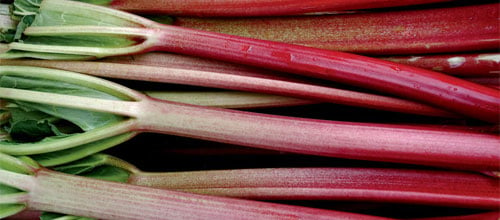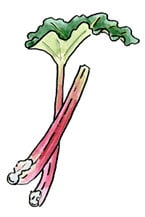Rhubarb
 Chipman's Canada Red rhubarb
Chipman's Canada Red rhubarbRhubarb is a long-lived perennial grown for its succulent, super-tart stalks. It is usually one of the first spring foods that can be eaten from the garden and at any time of the season it provides a good excuse for making pie.
Rhubarb is one of the least demanding of all crops. Once established, there's little work required. A happy plant will produce for decades. Grow rhubarb in full sun, in rich, lightly moist soil. In hot regions (USDA hardiness zone 6 and higher), plant rhubarb where it will get some protection from hot afternoon sun. Rhubarb will not thrive in a soggy location, where it will be susceptible to root rot, one of the few problems rhubarb can encounter. If your soil is heavy and doesn't drain well, raised beds are a good option.
Rhubarb is a great pass-along plant. One way to get your rhubarb patch off to a fast start is to talk a fellow gardener into giving you a "chunk off the old block." The best time to do this is in early spring before the plant's leaves begin to unfurl. Use a sharp spade to slice down through the crown, taking out a piece with at least two pink knobs on top. You can also purchase container-grown plants from a garden center.
When preparing the planting hole, remember that this is a perennial plant that will grow for many years in the same spot. So dig a deep, wide hole (18" deep and 18-24" wide) and partially fill it with a 50:50 mix of compost or aged manure and good garden soil. Add a cup or two of all-purpose organic fertilizer and then place the roots in the hole and continue filling it, making sure that the buds end up 1-2" below the soil surface.
It is important to keep rhubarb plants well-watered for the first year or two. Mulch will help to minimize water loss and maintain a more consistent moisture level. To maintain good production, add a few shovelfuls of compost around the crowns each spring.
At maturity, a rhubarb plant gets to be about 3 feet in diameter, so plant them 3 to 4 feet apart in a 3- or 4-foot-wide bed. Four to six plants will provide plenty of stalks for most families. Harvest sparingly, starting in the second year. Rhubarb sends up Jack-in-the-beanstalk like flower stalks, sometimes reaching 6 feet tall. They are decorative, but use up some of the plant's energy. Remove the flowers as soon as they begin to form and you'll be able to keep picking tender rhubarb stalks right through the summer and into the fall.
Is Rhubarb Poisonous?
Only the stalks of rhubarb are edible. The leaves contain oxalate, making them poisonous when consumed in large quantities.
According to the Rhubarb Compendium, you'd have to eat a lot of rhubarb leaves for it to be deadly — approximately 11 pounds. "Note that a fraction of that can cause sickness."
 Eat the stalks, not the leaves.
Eat the stalks, not the leaves.Common-Sense Precautions
- Trim leaves from stalk right away.
- Wash the stalks before eating.
- Make sure children understand that only the stems are edible.
- Don't let your pets eat it.
- Don't use stalks after a frost (oxalic acid from leaves can migrate into stems).
Last updated: 09/14/2023
Print this Article:
Get the Dirt
Stay up to date on new articles and advice. Please fill out the information below.
